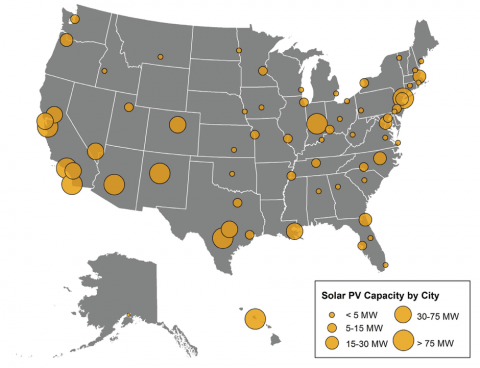A new report, prepared jointly by the nonprofit organizations Frontier Group and Environment America Research & Policy Center, has named six California cities among its Top 20 “Shining Cities.” These are the twenty cities that, according to the report’s survey, have the highest total installed solar PV capacity. Except for Texas – which can claim both San Antonio and Austin as part of the list of 20 – California was the only state that had more than one city in the survey.
San Diego was the leader of the entire Top 20, with 303MW (DC) of total solar PV installed, and Los Angeles placed second at 267MW (DC). (Note: all values in this article are rounded to whole numbers.) The other four California cities on the list, from most solar installed to least, are San Jose (4th) with 174MW (DC), San Francisco (11th) with 46MW (DC), Sacramento (13th) with 40MW (DC) and Riverside (15th) with 32MW (DC). This means that more than a quarter of the entire Top 20 list consists of California metropolitan areas.
San Diego was also second in rank among the 20 cities in per capita solar PV installed in 2016: 218W (DC) per person. Only Honolulu – which was third in total solar PV installed – ranked higher per capita. San Jose had 169W (DC) of installed solar per person (3rd place) in 2016; Sacramento had 81W (DC) per person (10th place); and Los Angeles 67W (DC) per person (15th place). San Francisco, in 17th place in installed solar per capita (54W (DC) per person) in 2016 joined, for the first time, the ranks of “Solar Stars”: that is, those cities with 50 or more watts of installed solar PV per person. Riverside saw the fastest rise over a two-year period in the per capita rankings, from 20th place in 2014 to 8th place in 2016 (with 99W (DC) per person).
The report, observing that “solar power is an American success story,” pointed out that the 20 cities in the list – which represent just one-tenth of one percent of U.S. land area – have nearly 2GW of solar PV capacity, almost as much as the total solar capacity of the U.S. less than seven years ago, in late 2010. The document also maintained that San Diego has, despite its solar leadership, developed less than 14 percent of its small building solar energy potential, so there’s still enormous room for growth. The city shouldn’t feel too bad, however: the majority of cities which the report cited have developed less than two percent of their solar potential.
Michelle Kinman, Clean Energy Advocate for the Environment California Research & Policy Center, was quoted in this article as saying, “San Diego has so much more untapped solar potential and we encourage city leaders to continue to embrace a big vision for solar on rooftops throughout the city.”
San Diego Mayor Kevin Faulconer said about the new report, “San Diego is setting the standard for other cities across the country when it comes to protecting our environment and creating a cleaner future. This new ranking is a testament to the many San Diego residents and businesses harnessing our natural resources as we march toward our goal of using 100 percent renewable energy throughout the city.”
The document had a number of observations and recommendations on the subject of solar in cities. The report stressed that those cities (and the states in which they are situated) that have adopted strong policies, such as net metering, for compensating solar customers for the energy they export to the grid are those most likely to appear on the list. It mentioned favorably the fact that San Francisco is the first major city in the nation to require that solar energy systems be installed during the construction of new buildings, and noted approvingly that the California government was considering expanding that policy to the entire state (see our article from February here). According to this article, “It is much easier and cheaper to install systems when the structure is designed for their inclusion and when there is already equipment on-site.”
Among the proposals that the report suggested to allow cities to reach their full solar potential were: a) local government should implement programs and policies that promote the rapid expansion of solar, b) solar access to all residents, including low-income residents, should be expanded, c) solar energy systems should be installed on government buildings, and d) state and federal officials and investor-owned utilities should be urged to facilitate the growth of solar energy.





